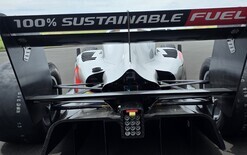New tech steers drivers away from danger

Ford has created a new technology for tis vehicles designed to help drivers avoid blind-spot collisions while travelling on multi-lane highways.
The new lane-keeping system with blind spot assist makes its global debut on the latest Ford Kuga SUV.
The technology monitors the driver’s blind spot for vehicles approaching from behind, and can apply counter-steering to warn the driver and discourage a lane change manoeuvre if a potential collision is detected.
Glen Goold, Kuga chief programme engineer, says: “Many drivers will at some point have been caught by surprise when another vehicle seemingly ‘appears out of nowhere’.
“Lane-keeping system with blind spot assist is like having an extra pair of eyes in the back of your head, helping prevent just a second’s lapse in judgement from escalating into something more serious.”
Failing to look properly or to judge another road user’s speed or direction was a factor in more than half of road accidents in the UK during 2018.
Ford has offered blind spot information system technology for more than a decade, which alerts drivers to the presence of vehicles in their blind spot using a warning light in the door mirror.
Its latest system goes further by being able to apply a gentle force to the steering wheel to discourage drivers from changing lanes into the path of another road user.
Radar sensors scan parallel lanes for vehicles up to 28 metres behind, 20 times per second, while driving at speeds over 65kph. An intervention can be automatically activated if the control system senses a lane-change by monitoring road markings using the forward-facing camera, and the technology calculates that the two vehicles are on a collision course.
Another safety feature making its debut on the new Kuga is Ford’s intersection assist technology, which uses the forward-facing camera, combined with radar, to monitor for potential collisions with oncoming vehicles in parallel lanes.
The technology can automatically apply the brakes when travelling at up to 30kph to help prevent or mitigate the effects of accidents in scenarios where a driver is turning across the path of an oncoming vehicle.





